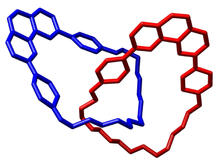Catenanes


In chemistry, catenanes are substances that consist of two or more rings - mostly macrocycles - linked mechanically (like links in a chain) . These rings cannot be separated from one another without breaking at least one covalent ring bond of a macrocyclic ring. The name catenane goes back to the Latin word catena , which means "chain". In addition to the catenanes, rotaxanes and molecular nodes belong to the group of mechanically linked molecular architectures.
history
The idea of synthesizing interlocked molecules is usually attributed to Richard Willstätter in a seminar in Zurich between 1906 and 1912. Serious attempts at synthesis began in the 1950s (including Arthur Lüttringhaus and Friedrich Cramer , initially unsuccessful). The first experimental evidence of the synthesis of a catenane (albeit in low yield) was made by Edel Wasserman in 1960, at that time at Bell Laboratories . He also introduced the term catenane. The synthesis of catenanes by means of directed covalent bonds (based on a basic concept by Wasserman and Harry L. Frisch ) took place in 1964 by Lüttringhaus and Gottfried Schill . Another method goes back to Wasserman (and independently the chemist at DuPont Norman M. van Gulick in the late 1950s), the Möbiusband synthesis, realized in the 1980s by David M. Walba . For a long time, however, the synthesis of catenanes was only possible in low yields and complicated synthetic steps until the template method with metal complexes by Jean-Pierre Sauvage revolutionized the field in 1983. From the beginning of the 1990s he synthesized n-catenanes (with n = 2 to 7 rings). Among other things, Sauvage received the Nobel Prize in Chemistry for this in 2016 .
synthesis
There are two different methods for the synthesis of catenanes. When carrying out a cyclization reaction , one can hope that the rings will arrange themselves before the second and during subsequent cyclizations in such a way that the desired catenane is formed. This is the so-called "statistical approach" that led to the first synthesis of a catenane. However, this method is very inefficient. At most, if the reaction partners are highly diluted in the mechanical linkage and there is a large excess of the first macrocyclic ring previously formed, this process works reasonably well. This synthesis principle is primarily of historical importance.
The second method is based on supramolecular preorganization of the macrocyclic precursors using hydrogen bonds , the coordination of metals, hydrophobic forces or Coulomb interactions . These non-covalent interactions compensate for the entropic disadvantages of the association and direct the starting materials to favorable locations for the formation of the desired catenanes during the final ring closure. This “template-controlled” approach, with the simultaneous application of high pressure, can lead to catenanes in yields of over 90%.
- Catenan families
Special catenanes
In 1994, the researchers James Fraser Stoddart and David Amabilino and their research groups succeeded in synthesizing a [5] catenane, which they called Olympiadane (German Olympiadan ), based on the five Olympic rings . The Olympiadan has no explicit purpose, but is only a contribution to basic research, the synthesis should investigate the feasibility of such syntheses.
See also
literature
- Gottfried Schill: Catenanes, Rotaxanes and Knots, Academic Press 1971, ISBN 9781483275666 (Organic chemistry: a series of monographs 22)
- Jean-Pierre Sauvage, Christiane Dietrich-Buchecker (Eds.): Molecular Catenanes, Rotaxanes and Knots , Wiley-VCH 1999
- Guzmán Gil ‐ Ramírez, David A. Leigh, Alexander J. Stephen: Catenane, fifty years of molecular entanglements, Angewandte Chemie, Volume 127, 2015, pp. 6208–6249, online
- Y. Liu, SA Vignon, X. Zhang, PA Bonvallet, SI Khan, KN Houk and JF Stoddart : Dynamic Chirality in Donor-Acceptor Pretzelanes. In: The Journal of Organic Chemistry. Volume 70, No. 23, 2005, pp. 9334-9344, doi : 10.1021 / jo051430g (detailed molecular structure) .
- Julien Frey, Tomá Kraus, Valérie Heitz and Jean-Pierre Sauvage: A catenane consisting of a large ring threaded through both cyclic units of a handcuff-like compound. In: Chemical Communications . Volume 42, 2005, pp. 5310-5312, doi : 10.1039 / B509745B (detailed molecular structure) (PDF; 69 kB).
- O. Safarowsky, B. Windisch, A. Mohry, F. Vögtle : Nomenclature for Catenanes, Rotaxanes, Molecular Knots, and Assemblies Derived from These Structural Elements. In: Journal for practical chemistry . Volume 342, No. 5, 2000, pp. 437-444, doi : 10.1002 / 1521-3897 (200006) 342: 5 <437 :: AID-PRAC437> 3.0.CO; 2-7 .
Individual evidence
- ↑ Guzmán Gil ‐ Ramírez, David A. Leigh, Alexander J. Stephen: Catenane, fifty years of molecular entanglements, Angewandte Chemie, Volume 127, 2015, pp. 6208–6249, online
- ↑ E. Wasserman, J. Am. Chem. Soc., Vol. 82, 1960, pp. 4433-4434
- ^ Edel Wasserman: Chemical Topology, Scientific American, November 1962
- ↑ Lüttringhaus, Schill, Targeted synthesis of catena compounds (1), Angewandte Chemie, Volume 76, 1964, pp. 567-568
- ↑ Jean-Pierre Sauvage, Christiane Dietrich-Buchecker , JP Kinzinger: Une nouvelle famille de molecules: les metallo-catenanes, Tetrahedron Letters, Volume 24, 1983, pp. 5095-5098
- ↑ David B. Amabilino, Peter R. Ashton, Anatoli S. Reder, Neil Spencer, J. Fraser Stoddart: Olympiadane. In: Angewandte Chemie International Edition . Volume 33, 1994, pp. 1286-1290, doi : 10.1002 / anie.199412861 .



